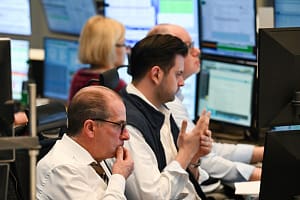Euro fell slightly by 0.5% against the US Dollar (EUR/USD) at approximately 9:50 a.m. GMT, after rebounding slightly from its lowest levels during the session at 1.08501, which is slightly close to the lowest levels in about two weeks. As for the British pound, the euro (EUR/GBP) was able to recover slightly after reaching the lowest levels in about two months at 0.85574 during the first minutes of today’s Asian markets trading session.
The mixed performance of the euro today comes with mixed numbers for the economies of the region and the region as a whole, in addition to the continued decline in European bond yields, which in turn created more pressure.
We witnessed a better-than-expected improvement in the German trade balance, in contrast to a greater-than-expected decline in exports and imports. In addition, we have seen better than expected signs for the Spanish labor market. Finally, the Eurozone showed some signs of improvement in the confidence in the region’s economy.
The trade balance recorded a larger surplus than expected last October, at 17.8 billion euros. However, this was accompanied by a larger than expected decline in exports by 0.2% and imports by 1.2%, with growth expected at 1.1% and 0.8%, respectively. On an annual basis, exports and imports fell by 8.1% and 16.3%, respectively.
The pressure on Germany’s foreign trade came as a result of the decline in trade with the European Union and Eurozone countries, which declined significantly during October. On a monthly basis, foreign trade fell by 2.7% and 2.8% for exports and imports between Germany and the European Union. As for the euro zone countries, exports and imports declined by 1.9% for exports and imports as well.
This weakness in the intra-region trades within the Eurozone is not surprising, with the continued contraction in economic activities, which albeit has been showing some signs of slow improvement over the past two months.
However, trade with countries outside the European Union provided support to the German trade balance. Exports and imports between Germany and countries outside the European Union increased by 2.9% and 0.8%, respectively.
The most notable growth was in trade exchange with the United States, China, and the United Kingdom, with growth of 5.7%, 1.5%, and 5.6% for each.
Within the Eurozone as well, the Spanish labor market has shown some signs of improvement. The number of unemployed decreased more than expected by 25 thousand during last November, compared to expectations of an increase by 28 thousand. Thus, the number of unemployed has reached approximately 2.734 million, which represents the lowest levels since 2007.
As for the eurozone as a whole, we have seen more signs of confidence in the eurozone economy. Investors’ pessimism fell to its lowest level since last May, with the latest reading of the Sentix Investor Confidence index for the Eurozone at -16.8%, while that reading was weaker than expected at -15.
Today’s decline in pessimism comes after a previous series of data that we witnessed over the past two months, which also reflected a gradual decline in pessimism about the region’s economy’s ability to recover and return to growth, whether on the part of the consumer or investor.
Previous readings of the ZEW Economic Sentiment index for Germany and the Eurozone and the GfK Consumer Climate index for Germany had indicated this decline in pessimism as well. On the other hand, and at the same time, we do not find that much of optimism that the region’s economy will soon return to growth in the near future, with the continued contraction of economic activities and the continued upward fears of inflation.
Despite the gradual return to sentiment in the Eurozone, the decline in European bond yields and the return of the gap between them and US Treasury yields to an increase may put further pressure on the euro.
The European government bonds yield reached 2.366% today, which is slightly close to the lowest levels since last July. While the US Treasury bond yield for the same term is also near its lowest level in three months, the gap between it and its European counterpart continues to rise, reaching 1.877% today, which represents the highest level in two weeks.






Leave a Comment